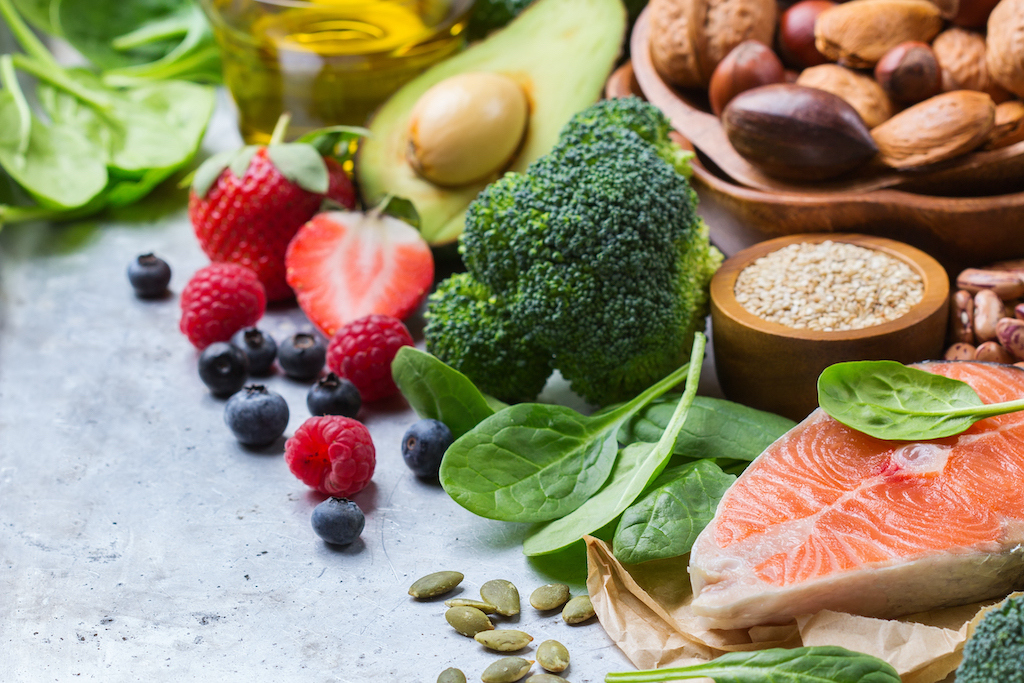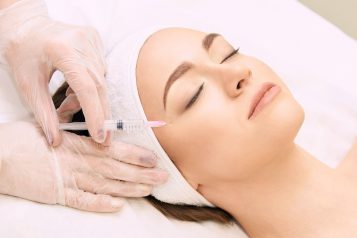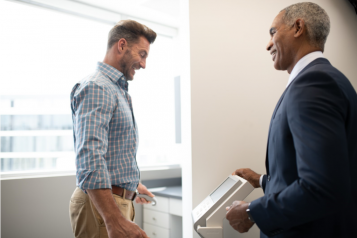Dr. Karan Chopra was guided and advised by visionaries of the field with hands-on experience at the esteemed Johns Hopkins Hospital in Baltimore, MD. There he honed his skills in complex facial and orbital reconstructive surgery at the R Adams Cowley Shock Trauma Center; completing a dual aesthetic and oculoplastic fellowship with Dr. Mark Codner. At the forefront of advancing cosmetic surgery, his revolutionary techniques and artful hand yield natural-looking results unique to each of his patients. Recognized for his prominent education and training pedigree, Dr. Chopra is revered for his leadership and research in Plastic and Reconstructive Surgery. He has authored 53 peer-reviewed research articles and has given over 20 lectures across the U.S. Haute Beauty expert Dr. Karan Chopra goes over post-op care, a nutritional diet, and medication after a facelift for a quick recovery.
 Photo Credit: Shutterstock
Photo Credit: Shutterstock
After a significant amount of research, you are ready to commit and schedule your facelift. You know what type of plastic surgeon you need to help you realize your vision, you are prepared to map out your plastic surgery process, and you managed to save and allocate the necessary funds.
Dr. Karan Chopra is a John Hopkins-trained Plastic Surgeon with specialized training in facial, breast, and body plastic and reconstructive surgery and a fellowship in oculoplastic aesthetics. With a fellowship training in complex facial and orbital reconstructive surgery, he skillfully shapes and molds the face, creating a natural and youthful look.
When considering facial rejuvenation, it is crucial to keep your aesthetic goals, skin condition, neck, cheeks, and jawline in mind. The Mini Facelift, Full Facelift, and Full Facelift with Necklift are all options, and each offers varied results. Dr. Chopra shares his professional procedural preparation, post-operation, and healing insight.
The Face Lift Gets An Update
While many reconstructive surgeons still use a classic “Mummy Wrap” to prevent swelling, Dr. Chopra finds this outdated approach traps the swelling and slows the healing process. Instead, he uses a series of nerve blocks to keep his patients comfortable. This methodology allows any potential excess bruising or hematomas to be visible and easily treatable, should they occur.
Dr. Chopra performs a modern Facelift that elevates the deeper tissues and yields a quicker healing time, less swelling, and natural results. He approaches each procedure underneath the skin and repositions the SMAS, muscle, and tissues, allowing results to be more natural and reflective of youth and less of a distorted or ‘stretched’ appearance.
The post-operative sleeping position plays a pivotal role in the quick recovery healing process. Instead of sleeping upright, Dr. Chopra recommends lying flat on the back, allowing swelling to flow with gravity and dissipate through the back of the neck. A soft neck-roll pillow helps to make this position more comfortable.
One Week To Change Your Life
Dr. Chopra cares for his patients beyond the procedure with post-operative check-ups. Good nutrition and rest are vital components of a comprehensive plan to support the body and improve healing. He, his staff, and his patients have prepared a checklist of necessary and healthy essentials for the surgical journey.
Dr. Chopra offers the quick recovery facelift at his office, Twin Cities Cosmetic Surgery, in the suburbs of Minneapolis, MN. Dr. Chopra explains that out-of-state patients tend to visit “to achieve a specific type of result.” In less than one week, patients can undergo their procedure and experience first-class care in the best hotels while making a full quick recovery. If you don’t have someone who can travel with you to help you with your recovery, they can provide nursing service to support you post-operation.
His office is conveniently located 15 minutes from Minneapolis-Saint Paul International Airport (MSP), with direct flights from most major cities. During his ENVISIONS consultation, you will discuss your ultimate vision, fears, wishes, and desires alongside risks, benefits, and costs.
 Photo Credit: Shutterstock
Photo Credit: Shutterstock
Dr. Chopra and his team provide an out-of-town patient kit complete with suggested tips and packing checklist necessary for a complete and quick recovery:
Consume healthy foods. If you ever needed an excuse to make changes to your diet, now is the time. The proper nourishment of unprocessed, unrefined carbohydrates is vital to a speedy recovery. Begin making changes to your eating habits four to six weeks before surgery and continue for six weeks post-surgery. It’s essential to increase healthy fiber to ease constipation associated with anesthesia and pain medication. Dr. Chopra and his team encourage a low fat, high protein, low or no salt diet. Focus on eating fresh vegetables, fish, eggs, beans, avocados, nuts, seeds, grains, and fruits. Consider adopting the following healthy and hearty meals:
Main Proteins
● Ground Turkey or Chicken | Prepare with onions, garlic, low sodium seasoning & turmeric. Finish with a can of low sodium chickpeas for extra protein and fiber.
● Chicken Breast | Brush with olive oil and dust with your favorite low salt, no salt seasonings, a heavy sprinkle of turmeric, and cook in the air fryer or sauté on the cooktop.
● Salmon, Cod, Chilean Sea Bass, Sardines, & Trout | These fatty fish are healthy for everyday eating and are beneficial for a rapid post-surgery recovery. Pat fish filet of choice dry, brush with low sodium soy sauce, season with fresh crushed garlic, sprinkle with your favorite low salt, no salt seasoning, place skin side down and cook in an air fryer or sauté on the cooktop. Sardines and Trout can be eaten right out of the can and are delicious paired with a hearty, mixed greens salad.
Side Dishes
● Cauliflower, Broccoli, Brussel Sprouts, Kale, Spinach & other Green Veggies | Toss your vegetable of choice with a light sprinkle of extra virgin olive oil and your favorite low salt, no salt seasoning, and roast in the oven at 400 degrees or cook in the air fryer. These low carbohydrate sources of fiber are filling and a fantastic alternative for unhealthy rice, potatoes, and bread.
● Fruits & Avocado | Nutrient-dense, anti-oxidant, low glycemic fruits including blueberries, raspberries, strawberries, blackberries, and kiwi are great snacks or accessories to meals. Avocado is a delicious and hearty source of healthy oil and nutrients, perfect for breakfast, lunch, and/or dinner.
● Sweet Potato | Brush with olive oil and favorite low salt, no salt seasoning, turmeric, and broil in the oven at 400 degrees.
● Beans & Legumes | Pair your protein with your favorite can of low sodium black beans, chickpeas, etc. Smash for hummus or refried bean-inspired dish.
● Seeds & Whole Grains | Quinoa is an excellent source of protein and fiber and a perfect alternative for unhealthy rice, potatoes, and bread. It’s quick, easy, and delicious – follow the package instructions. Ezekiel is a smart low carbohydrate alternative to bread and pairs well with sliced eggs, salmon, and avocado.
● The Healing Smoothie Recipe
¾ cup Blueberries (frozen)
¾ cup Mixed Berries (frozen)
1 cup Oat or Almond Milk
2 scoops Protein Powder
2 scoops Collagen
Handful Spinach / Kale
2 Tb Almonds (unsalted & raw)
The Recovery Shopping List
 Water is Essential for Healing. Did you know that adult humans are 60 percent water, and our blood is 90 percent water? Blood serves as the vehicle to transport nutrients between cells, removes toxins, and catalyzes healing through hydration. Without water, dehydration occurs, which lowers blood volume, disrupts cell function, and impairs the surgical area’s healing. Dr. Chopra recommends drinking five or more 12 oz bottles of water daily. Herbal teas are a great way to increase water intake, and many have anti-inflammatory and pain-relieving benefits. Green and Arnica varietals promote circulation around the surgical area and reduce excess inflammation and swelling.
Water is Essential for Healing. Did you know that adult humans are 60 percent water, and our blood is 90 percent water? Blood serves as the vehicle to transport nutrients between cells, removes toxins, and catalyzes healing through hydration. Without water, dehydration occurs, which lowers blood volume, disrupts cell function, and impairs the surgical area’s healing. Dr. Chopra recommends drinking five or more 12 oz bottles of water daily. Herbal teas are a great way to increase water intake, and many have anti-inflammatory and pain-relieving benefits. Green and Arnica varietals promote circulation around the surgical area and reduce excess inflammation and swelling.
Medication Management. Before and after surgery, it is imperative to stop taking medication that affects the blood’s coagulation properties. There are quite a few over-the-counter and prescribed drugs that are on the no-no list, such as aspirin, ibuprofen, birth control pills, estrogen replacement, and estrogen creams, to name a few. Dr. Chopra recommends consulting with your surgeon for a customized approach.
Send Your Smoking Habit Packing. Cigarette smoke and nicotine use counteract the plastic surgery procedure. Nicotine reduces blood flow, the primary delivery source of nutrients to the wound site, slowing the overall healing process, leading to potential complications, or worse. Heather Furnas, MD of Santa Rosa, CA, cautions of the possible outcomes in an article featured on The American Society of Plastic Surgery website:
● Loss of cheek skin after a facelift
● Infections
● Death of fat cells (fat necrosis), causing hard lumps
● Delayed wound healing
● Thick, wide scars
● Blood clots, which can be fatal
● Increased pain
● Permanent small vessel damage adding risk even if you quit
● Life-threatening complications like stroke, heart attack, blood clots, and pneumonia
Choose the Right Surgeon For You
To learn more about a Quick Recovery Facelift, contact Dr. Chopra to schedule an ENVISIONS consultation. You will discuss your ultimate vision, fears, wishes, and desires alongside risks, benefits, and costs. Begin your confidence-boosting journey and contact Dr. Chopra at Twin Cities Cosmetic Surgery in Burnsville, MN at 952-435-0177 or email info@TCPlasticSurgery.com. Follow Dr. Chopra on Instagram @karanchopramd
For more information, visit Dr. Brian A. Levine's social media:

























